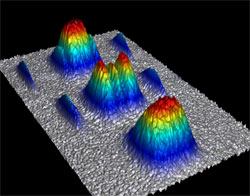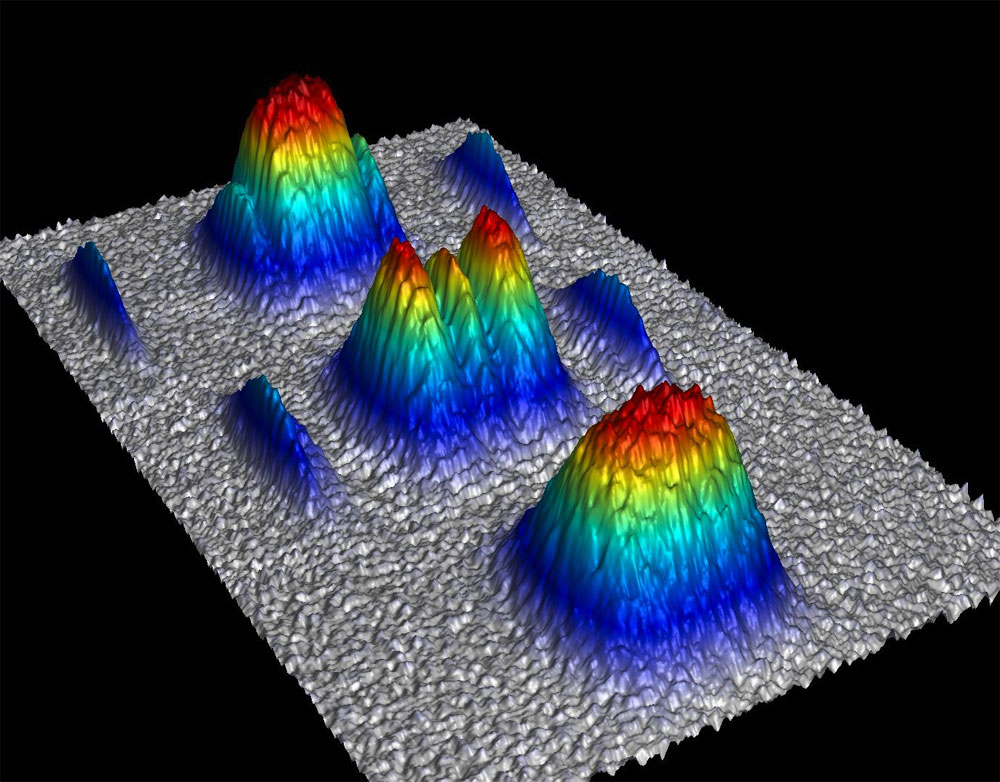Cold Atoms Reveal Their Crystalline Nature
Cold atoms in an optical trap can behave like the electrons in a solid crystal. The traps, which are easily manipulated, provide researchers with a test bed for understanding real crystals. Now a team reports 23 September in Physical Review Letters that they have extracted from this kind of simulated crystal an essential property–the band structure–that in real crystals characterizes the conductivity and related parameters. This was the first observation of the band structure for fermionic atoms–the kind that follow the same statistical rules as electrons. The technique should allow experimentalists to study deeper issues, such as the interaction of electrons with vibrations in crystals.
The trapping and cooling of gases with lasers and magnetic fields has become common in labs over the last two decades. In 2002 researchers created a so-called optical lattice by inducing a three-dimensional standing wave pattern with crossed laser beams. This pattern provided the equivalent of the valleys in an egg carton–locations to which atoms were attracted, just as electrons are attracted to the rigid lattice of ions in a crystal. But the parameters of an optical lattice can be tuned at will to study, for example, how the mobility of electron-like atoms decreases as the potential wells (the egg-carton valleys) inside a lattice deepen.
The periodicity of lattice points in a crystal leads to a bunching of electron energy levels into broad energy bands. The band structure of a material is the basis for its main electrical properties, such as its status as an insulator, conductor, or semiconductor, so measuring it is essential for understanding the electrons’ behavior. Two teams have recently observed band structures for atoms in optical lattices [1], but both experiments used bosonic atoms, which have different statistical properties than electrons. Now one of these teams, led by Klaus Sengstock of the University of Hamburg in Germany, has measured the complete band structure for fermionic atoms.
The researchers placed potassium atoms in their optical lattice and rapidly increased and decreased the depth of the potential wells by 15 percent. If the frequency of this modulation corresponded to the energy required by a ground-state atom to jump to a higher-energy band, then the atom could absorb the energy and make the leap to an excited state.
The team observed the results of the modulation by turning off the trapping lasers and letting the gas of atoms expand outward for roughly 20 milliseconds before taking an image of the gas. Those atoms in a higher band had greater momentum and therefore expanded farther out than atoms in the lowest energy band. Also observed were “holes” in the lowest band where excited atoms had vacated. As they increased the modulation frequency, the team was able to identify several bands with different energies in the potassium “crystal.”
With their band measuring technique in hand, the team explored the consequences of adding a bosonic rubidium gas to the fermionic potassium gas. Bosonic atoms could represent particles called phonons, which are quantized vibrations in a crystal lattice. Electron-phonon coupling has a role in superconductivity, so researchers have been studying the mutual attraction of fermionic and bosonic atoms placed in the same optical lattice. In their system, Sengstock and his colleagues found that the addition of rubidium led to a shift in the potassium bands, which was explained by potential wells in the lattice effectively becoming deeper when fermions and bosons shared the same wells.
Immanuel Bloch of the Max-Planck Institute for Quantum Optics in Munich says the shift in the lattice depth was expected from previous experiments, but he thinks the new method is simple and promising for characterizing more complicated optical lattice systems. It also bears a close resemblance to angle resolved photoemission spectroscopy (ARPES), which is widely used to study electronic properties of solids. “One can now compare the band structure data from solid-state physics to that from optical lattices,” Bloch says. He adds that since the technique can measure multiple bands, one can study other complexities of solids, such as magnetism.
–Michael Schirber
Michael Schirber is a Corresponding Editor for Physics Magazine based in Lyon, France.
References
- D Clément, N Fabbri, L Fallani, C Fort, and M Inguscio, New J. Phys. 11, 103030 (2009)
More Information
Focus on Cold Atoms in Optical Lattices, a series of articles in the New Journal of Physics in 2006
Atoms Team Up to Slow Down (Focus story, 2003)
Quantum Logic with an Optical Lattice (Focus story, 1999)





